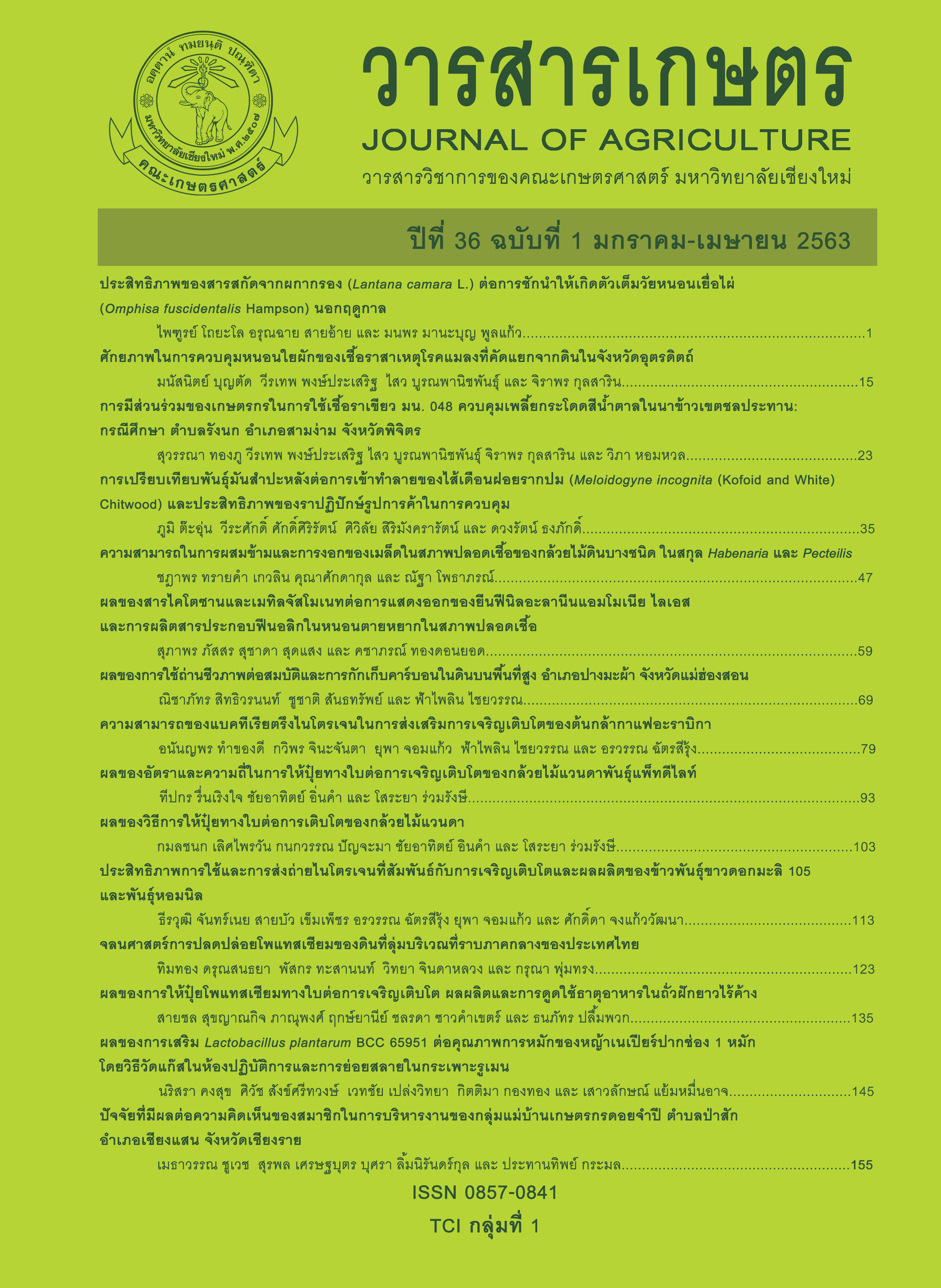ผลของการใช้ถ่านชีวภาพต่อสมบัติและการกักเก็บคาร์บอนในดินบนพื้นที่สูง อำเภอปางมะผ้า จังหวัดแม่ฮ่องสอน
Main Article Content
บทคัดย่อ
การศึกษาผลของการใช้ถ่านชีวภาพต่อสมบัติของดินและการกักเก็บคาร์บอนในดินจาก อำเภอปางมะผ้า จังหวัดแม่ฮ่องสอน ได้ดำเนินการที่ คณะเกษตรศาสตร์ มหาวิทยาลัยเชียงใหม่ โดยแบ่งการศึกษาออกเป็น 2 การทดลอง และวางแผนการทดลองแบบสุ่มสมบูรณ์ จำนวน 4 ซ้ำ การทดลองที่ 1 ศึกษาผลของการใช้ถ่านชีวภาพต่อการเปลี่ยนแปลงสมบัติของดิน โดยนำถ่านชีวภาพขนาดแตกต่างกัน 3 ขนาด (2-5, 1-2 และน้อยกว่า 1 มิลลิเมตร) ไปผสมกับดินในอัตราที่แตกต่างกัน (0.1, 1.0 และ 3.0 เปอร์เซ็นต์ (w/w)) นำไปปรับความชื้นของดินที่ความจุความชื้นสูงสุดของดิน แล้วปล่อยให้แห้งในสภาพอุณหภูมิห้อง แล้วนำไปวิเคราะห์สมบัติของดิน สำหรับการทดลองที่ 2 เป็นการศึกษาผลของการใช้ถ่านชีวภาพต่อการกักเก็บคาร์บอนในดิน โดยการผสมถ่านชีวภาพลงไปในดินอัตราที่แตกต่างกัน (0.1, 1.0 และ 3.0 เปอร์เซ็นต์ (w/w)) เปรียบเทียบกับดินที่เติมตอซังข้าวโพด อัตรา 2 ตัน/ไร่ และกรรมวิธีควบคุม ทำการปรับความชื้นของดินให้อยู่ที่ 50 เปอร์เซ็นต์ของความจุความชื้นสูงสุด นำไปบ่มไว้ที่อุณหภูมิห้อง หลังการบ่มดิน 1 เดือน ทำการวิเคราะห์หาปริมาณคาร์บอนที่เหลือในดิน ผลการศึกษาพบว่า การใช้ถ่านชีวภาพในอัตราตั้งแต่ 1 เปอร์เซ็นต์ ทำให้ความหนาแน่นรวมของดินลดลง ในขณะที่ความสามารถในการอุ้มน้ำของดิน ความเป็นกรดด่างของดิน การนำไฟฟ้า อินทรียวัตถุ ฟอสฟอรัสที่เป็นประโยชน์ และโพแทสเซียมที่แลกเปลี่ยนได้เพิ่มสูงขึ้นอย่างมีนัยสำคัญทางสถิติ และนอกจากนั้นพบว่าดินที่เติมถ่านชีวภาพ มีการสูญเสียคาร์บอนอยู่ในช่วง 0.16-0.26 เปอร์เซ็นต์ ซึ่งไม่แตกต่างจากกรรมวิธีควบคุมอย่างมีนัยสำคัญทางสถิติ แต่ดินที่เติมตอซังข้าวโพดในอัตรา 2 ตัน/ไร่ มีการสูญเสียคาร์บอนสูงถึง 0.44 เปอร์เซ็นต์ ซึ่งมากกว่ากรรมวิธีอื่นอย่างมีนัยสำคัญทางสถิติ การศึกษานี้ชี้ให้เห็นว่า การนำถ่านชีวภาพมาใช้เป็นวัสดุปรับปรุงบำรุงดิน เป็นแนวทางหนึ่งที่จะเพิ่มความอุดมสมบูรณ์ดิน และยังสามารถเพิ่มการกักเก็บคาร์บอนไว้ในดินได้มากว่าการไถกลบตอซัง ซึ่งสามารถเก็บกักคาร์บอนในดินได้ถึง 45 เปอร์เซ็นต์
Article Details
เอกสารอ้างอิง
Analytik Jena AG. 2017. Operating manual multi EA 4000 Elemental analyzer C, S and Cl solid analysis. Instruction Manual. Analytik Jena AG. Konrad-Zuse-Str.1, Germany. 302 p.
Atkinson, C.J., J.D. Fitzgerald and N.A. Hipps. 2010. Potential mechanisms for achieving agricultural benefits from biochar application to temperate soils: a review. Plant and Soil 337(1-2): 1-18.
Bray, R.H. and L.T. Kurtz. 1945. Determination of total, organic, and available forms of phosphorus in soils. Soil Science 59(1): 39-45.
Chen, M., N. Alim, Y. Zhang, N. Xu and X. Cao. 2018. Contrasting effects of biochar nanoparticles on the retention and transport of phosphorus in acidic and alkaline soils. Environmental Pollution 239: 562-570.
Hemwong, S. 2013. Biochar: carbon sequestration and soil fertility. King Mongkut’s Agricultural Journal 31(1): 104-113. (in Thai)
Houben, D., L. Evrard and P. Sonnet. 2013. Mobility, bioavailability and pH-dependent leaching of cadmium, zinc and lead in a contaminated soil amended with biochar. Chemosphere 92(11): 1450-1457.
Jezierski, S. 2015. Determination of different carbon species in solids - using the real chemistry to obtain the right results. (Online). Available: https://www.envirotech-online.com/ article/environmental-laboratory/ 7/analytik-jena-ag/determination-of-different-carbon-species-in-solids-ndash-using-the-real-chemistry-to-obtain-the-right-results/1938 (April, 30, 2019)
Klodpeng, T. 1985. Methods of Soil Physical Analysis. Faculty of Agriculture, Chiang Mai University, Chiang Mai. 205 p. (in Thai)
Land Development Department. 2005. Manual for Stop Slash Burning, Sustainable Soil and Environmental Restorations. Land Development Department, Bangkok. 20 p. (in Thai)
Lehmann, J. 2007. Bio-energy in the black. Frontiers in Ecology and the Environment 5(7):
-387.
Lehmann, J. and M. Rondon. 2006. Bio-char soil management on highly weathered soil in the humid tropics. pp. 517-530. In: N. Uphoff, A.S. Ball, E. Fernandes, H. Herren, O. Husson, M. Laing, C. Palm, J. Pretty, P. Sánchez, N. Sanginga and J. Thies (eds.). Biological Approaches to Sustainable Soil Systems. CRC Press, Boca Raton, FL.
Lehmann, J., J. Gaunt and M. Rondon. 2006. Biochar sequestration in terrestrial ecosystems - a review. Mitigation and Adaptation Strategies for Global Change 11(2): 403-427.
Liang, B., J. Lehmann, D. Solomon, J. Kinyangi, J. Grossman, B. O’Neill, J.O. Skjemstad, J. Thies, F.J. Luizao, J. Petersen and E.G. Neves. 2006. Black carbon increases cation exchange capacity in soils. Soil Science Society of America Journal 70: 1719-1730.
Mankasingh, U., P.C. Choi and V. Ragnarsdottir. 2011. Biochar application in a tropical, agricultural region: A plot scale study in Tamil Nadu, India. Applied Geochemistry 26(Suppl.): S218-S221.
Panomtaranichagul, M. 1987. Soil Physics. Faculty of Agriculture, Chiang Mai University, Chiang Mai. 514 p. (in Thai)
Santasup, C., K. Inthani, K. Sringarm. W. Spreer and T. Supriyasilp. 2016. Reduced CO2 Emissions, Enhanced Soil Fertility and High Water Holding Capacity by Improved Fallow Management Based on Biochar Application in Highland Agriculture. Research report. Faculty of Agriculture, Chiang Mai University, Chiang Mai. 105 p. (in Thai)
Schweikle, J., W. Spreer, K. Sringarm, S. Karaj, C. Santasup and J. Müller. 2016. Analysis of biochar from different kinds of feedstock and varying pyrolysis temperature I: Chemical and microscopic properties. Journal of Agriculture 32(Suppl.): 43-53.
Siwasilp, N. 1984. Manual of Soil and Plant Analysis. Faculty of Agriculture, Chiang Mai University, Chiang Mai. 138 p. (in Thai)
Steinbeiss, S., G. Gleixner and M. Antonietti. 2009. Effect of biochar amendment on soil carbon balance and soil microbial activity. Soil Biology and Biochemistry 41(6): 1301-1310.


